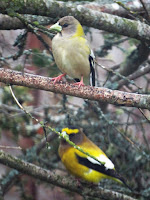EVENING GROSBEAK
EVENING GROSBEAK – (Coccothraustes vespertinus) – (See images below)
DESCRIPTION: The Evening Grosbeak has a massive conical bill (hence the name). The adult male has a bright yellow bar above the bill and eyes, and its under parts are yellow. The head and neck are dark brown, the wings black and white, and the tail is black.The bill is creamy to light grey, and the legs and feet are pink. Females are grey with black and white wings. This species is approximately 20 cm (8 inches) long.
VOICE: https://www.xeno-canto.org/species/Hesperiphona-vespertina
NAME: This bird is called ‘evening’ grosbeak due to the mistaken belief by Rocky Mountains area settlers in the early 1800s that it was coming from out of the woods in late afternoon. This belief also gave the bird its Latin species name, ‘vespertinus’. As for the Latin genus name ‘coccothraustes’, it comes from ancient Greek and means breaking a seed or kernel.
HABITAT: Forests with conifers, especially spruce.
DIET: The evening grosbeak has a preference for the spruce budworm, a coniferous forest pest. It also eats other insects, seeds and berries, and is easily attracted to bird feeders. Aside from seeds provided by humans, one of its favorite foods in the winter is the seed of the Box Elder (acer negundo).
NESTING: This species builds its nest Around four light blue eggs are laid, which are incubated by
DISTRIBUTION: The evening grosbeak’s breeding range now covers most of southern Canada and the western USA. This bird extended its breeding range from out west perhaps due to the planting of box elders in cities across those two countries.
DISTRIBUTION MAP: https://en.wikipedia.org/wiki/Evening_grosbeak#/media/File:Coccothraustes_vespertinus_map.svg
ON PEI: Although the evening grosbeak is known to breed on Prince Edward Island, its presence is not regular, but rather rare or occasional. In the winter there can be ‘irruptive’ flocks observed, depending on food availability.
CONSERVATION: Because of this bird’s preference for the spruce budworm, it is vulnerable to pesticide spraying, and its numbers have declined sharply. However a definitive link has not yet been established, since another factor might be habitat loss from commercial harvesting of conifer forests. The bird is listed as of ‘Special Concern’ by COSEWIC (see reference below), and as ‘vulnerable’ by the IUCN. What helps it however is the planting of box elders, as their seeds are a favorite food source.
NOTES: One might think that the Evening grosbeak should be part of the Grosbeak and Cardinal family, like the Rose-breasted Grosbeak. However it is rather a member of the Finch family, like the Pine Grosbeak.
SIMILAR SPECIES: The smaller American Goldfinch (in breeding plumage)
REFERENCES: https://www.mba-aom.ca/jsp/toc.jsp (Maritimes Breeding Birds Atlas)
http://www.hww.ca/en/wildlife/birds/evening-grosbeak.html
https://www.allaboutbirds.org/guide/Evening_Grosbeak/id
https://en.wikipedia.org/wiki/Evening_grosbeak
https://www.canada.ca/en/environment-climate-change/services/species-risk-public-registry/cosewic-assessments-status-reports/evening-grosbeak-2016.html
https://www.audubon.org/field-guide/bird/evening-grosbeak
https://nature.mdc.mo.gov/discover-nature/field-guide/evening-grosbeak (Missouri Department of Conservation)
DESCRIPTION: The Evening Grosbeak has a massive conical bill (hence the name). The adult male has a bright yellow bar above the bill and eyes, and its under parts are yellow. The head and neck are dark brown, the wings black and white, and the tail is black.The bill is creamy to light grey, and the legs and feet are pink. Females are grey with black and white wings. This species is approximately 20 cm (8 inches) long.
VOICE: https://www.xeno-canto.org/species/Hesperiphona-vespertina
NAME: This bird is called ‘evening’ grosbeak due to the mistaken belief by Rocky Mountains area settlers in the early 1800s that it was coming from out of the woods in late afternoon. This belief also gave the bird its Latin species name, ‘vespertinus’. As for the Latin genus name ‘coccothraustes’, it comes from ancient Greek and means breaking a seed or kernel.
HABITAT: Forests with conifers, especially spruce.
DIET: The evening grosbeak has a preference for the spruce budworm, a coniferous forest pest. It also eats other insects, seeds and berries, and is easily attracted to bird feeders. Aside from seeds provided by humans, one of its favorite foods in the winter is the seed of the Box Elder (acer negundo).
NESTING: This species builds its nest Around four light blue eggs are laid, which are incubated by
DISTRIBUTION: The evening grosbeak’s breeding range now covers most of southern Canada and the western USA. This bird extended its breeding range from out west perhaps due to the planting of box elders in cities across those two countries.
DISTRIBUTION MAP: https://en.wikipedia.org/wiki/Evening_grosbeak#/media/File:Coccothraustes_vespertinus_map.svg
ON PEI: Although the evening grosbeak is known to breed on Prince Edward Island, its presence is not regular, but rather rare or occasional. In the winter there can be ‘irruptive’ flocks observed, depending on food availability.
CONSERVATION: Because of this bird’s preference for the spruce budworm, it is vulnerable to pesticide spraying, and its numbers have declined sharply. However a definitive link has not yet been established, since another factor might be habitat loss from commercial harvesting of conifer forests. The bird is listed as of ‘Special Concern’ by COSEWIC (see reference below), and as ‘vulnerable’ by the IUCN. What helps it however is the planting of box elders, as their seeds are a favorite food source.
NOTES: One might think that the Evening grosbeak should be part of the Grosbeak and Cardinal family, like the Rose-breasted Grosbeak. However it is rather a member of the Finch family, like the Pine Grosbeak.
SIMILAR SPECIES: The smaller American Goldfinch (in breeding plumage)
REFERENCES: https://www.mba-aom.ca/jsp/toc.jsp (Maritimes Breeding Birds Atlas)
http://www.hww.ca/en/wildlife/birds/evening-grosbeak.html
https://www.allaboutbirds.org/guide/Evening_Grosbeak/id
https://en.wikipedia.org/wiki/Evening_grosbeak
https://www.canada.ca/en/environment-climate-change/services/species-risk-public-registry/cosewic-assessments-status-reports/evening-grosbeak-2016.html
https://www.audubon.org/field-guide/bird/evening-grosbeak
https://nature.mdc.mo.gov/discover-nature/field-guide/evening-grosbeak (Missouri Department of Conservation)
 |
| Evening grosbeak male, QC, by Cephas |
 |
| Evening grosbeak pair, PEI by Sandra Meade |
 |
| Evening grosbeak female, ON, by Mdf |